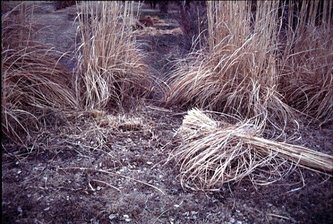
Another question we often receive is whether we can divide ornamental grasses in the fall. Spring is the preferred time because divisions done in the fall may not root well enough to survive the winter. (Ward Upham)
| K-State Research and Extension Horticulture Newsletter |
|
 We are starting to receive questions on whether it is best to cut back ornamental grasses in the fall or spring. As a rule, ornamental grasses should not be cut back while green because they need time to move the energy found in the foliage into the roots. Even when browned by cold weather, most gardeners will leave the foliage until spring because of the interest it adds to winter landscapes. Early March is the preferred time to cut back these plants. However, dry foliage is extremely flammable and should be removed in the fall from areas where it is a fire hazard. Another question we often receive is whether we can divide ornamental grasses in the fall. Spring is the preferred time because divisions done in the fall may not root well enough to survive the winter. (Ward Upham)
0 Comments
 March is a good time to remove dead foliage from ornamental grasses. Grasses green up earlier if foliage is removed and are more attractive without a mixture of dead and live leaves. A number of tools can be used including hand clippers, weed whips (if the foliage is of a small enough diameter), weed whips with a circular blade, or even a chain saw. Use the top of the chainsaw bar to cut so the saw doesn't pull in debris and clog. Also, it is often helpful to tie foliage together before cutting so it doesn't interfere and is easier to dispose of. Burning is another option — but only if it is safe and legal to do so. Note that these grasses may not burn long, but they burn extremely hot. Even so, the crown of the plant is not damaged and new growth appears relatively quickly. If the center of the clump shows little growth, the plant would benefit from division. Dig up the entire clump and separate. Then replant the vigorous growth found on the outer edge of the clump. (Ward Upham) Video of the Week: |
AuthorsCynthia Domenghini runs the Horticulture Response Center in the Department of Horticulture and Natural Resources at Kansas State University. Other contributors include K-State Extension Specialists. Archives
March 2024
Categories
All
|